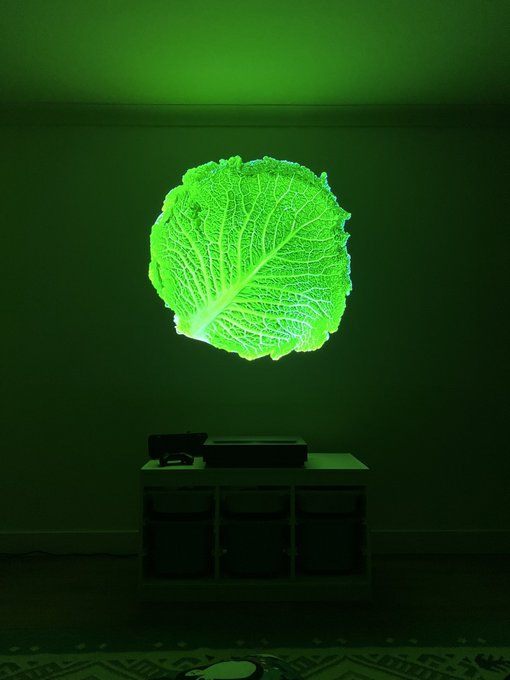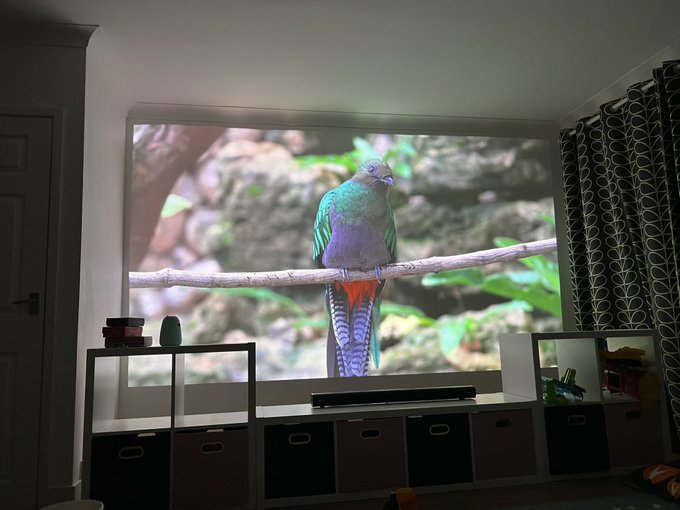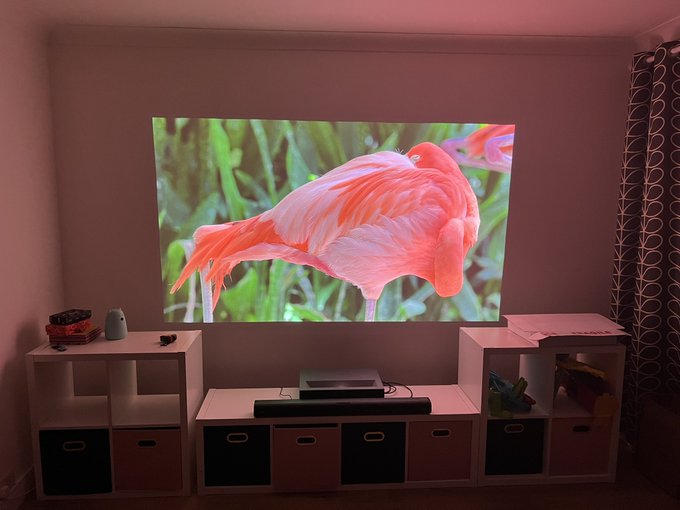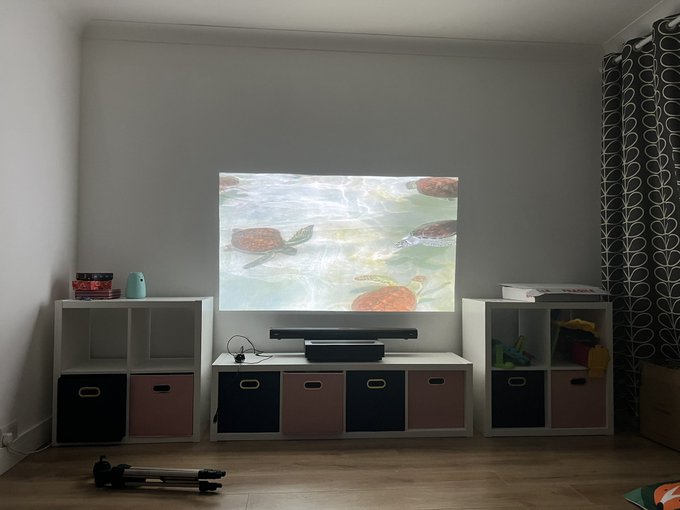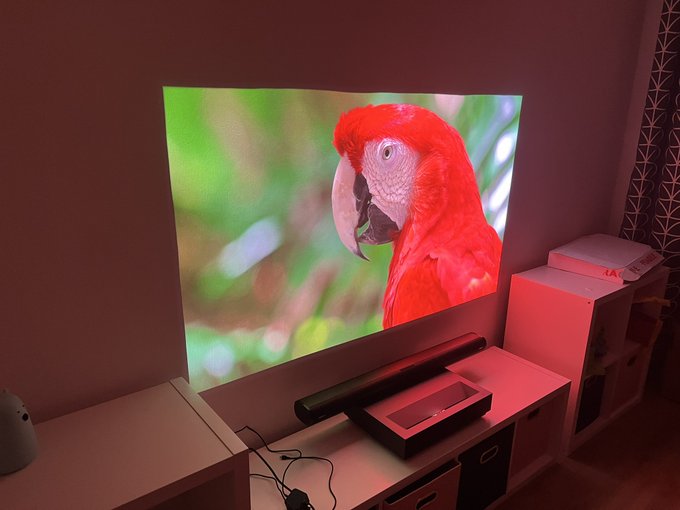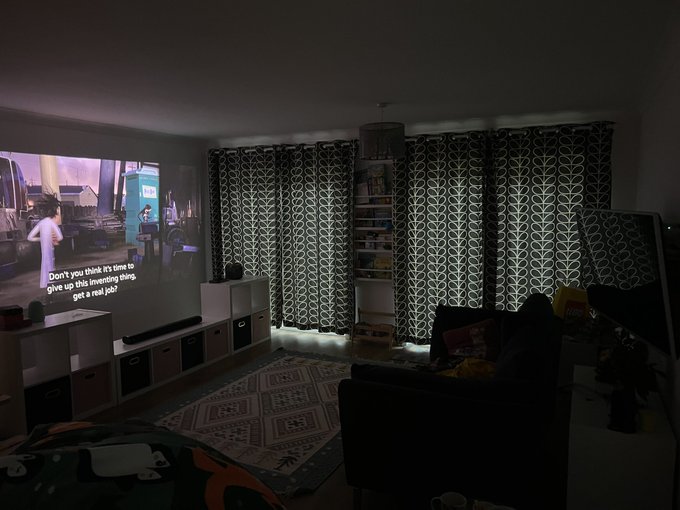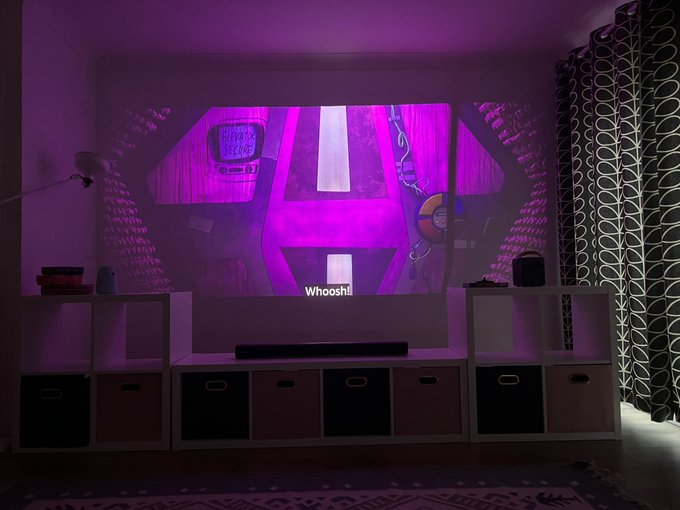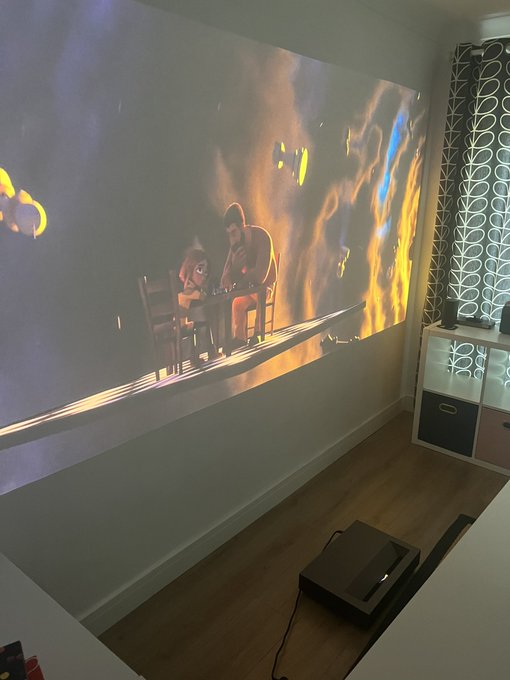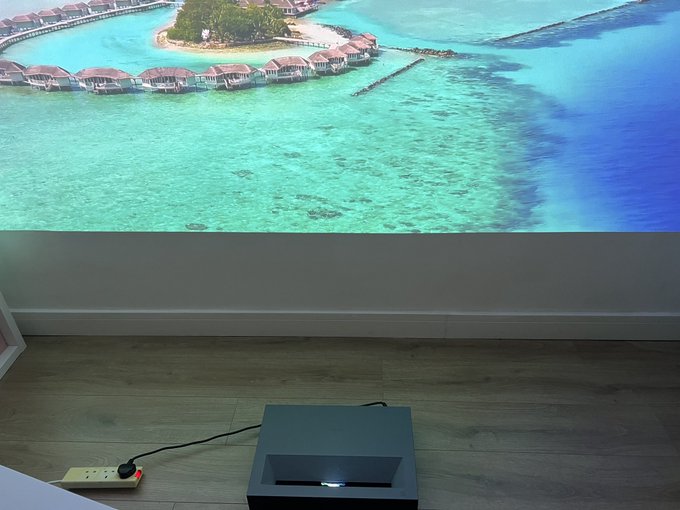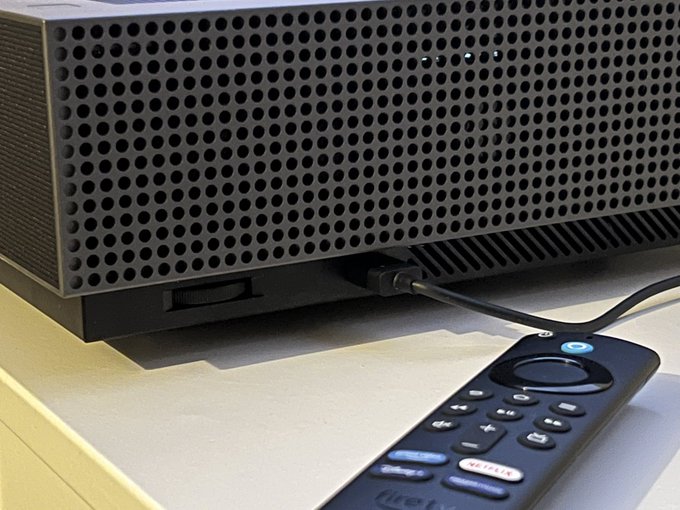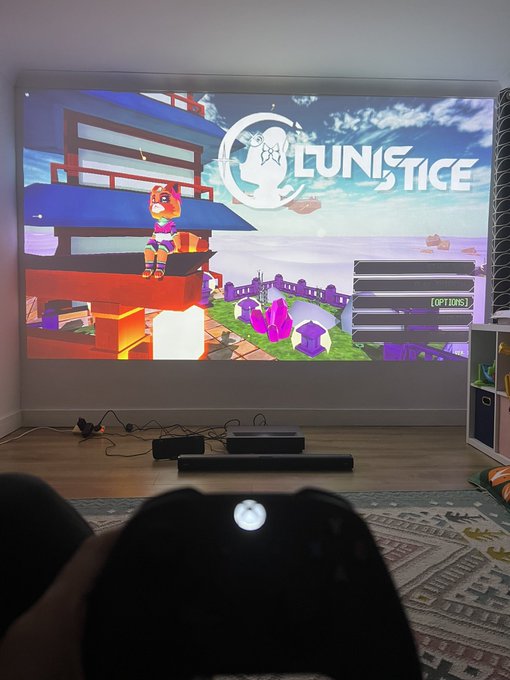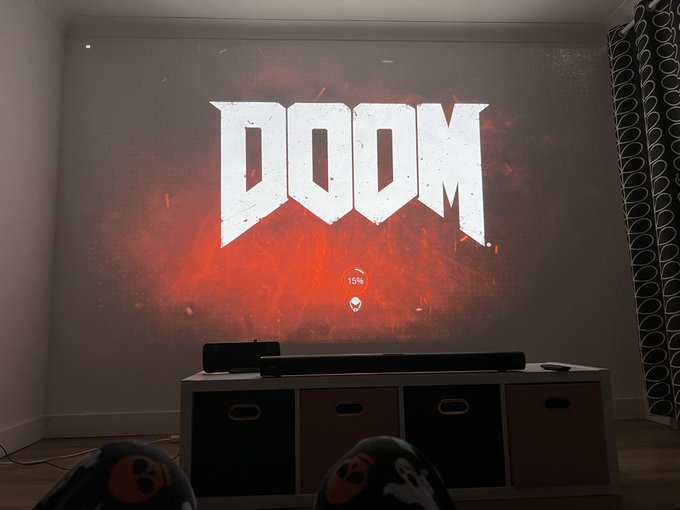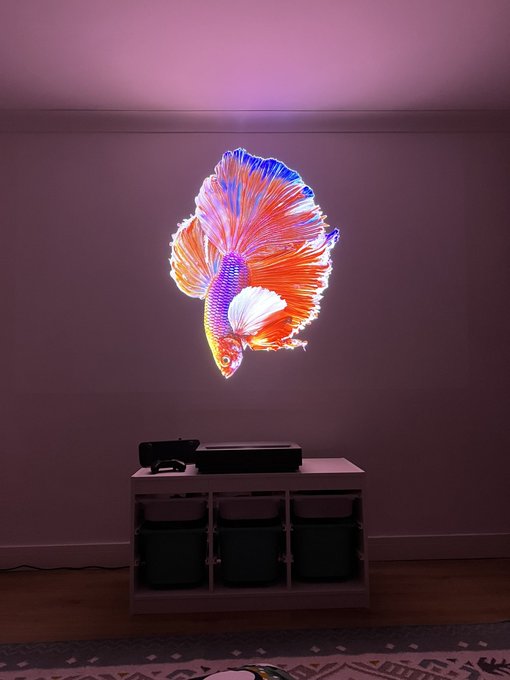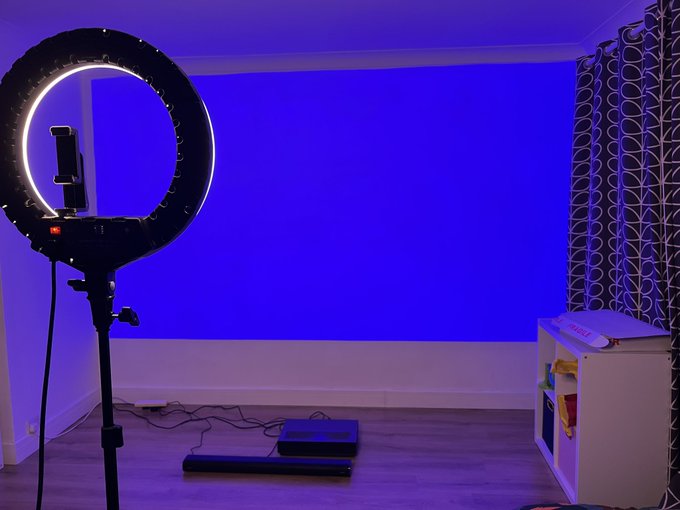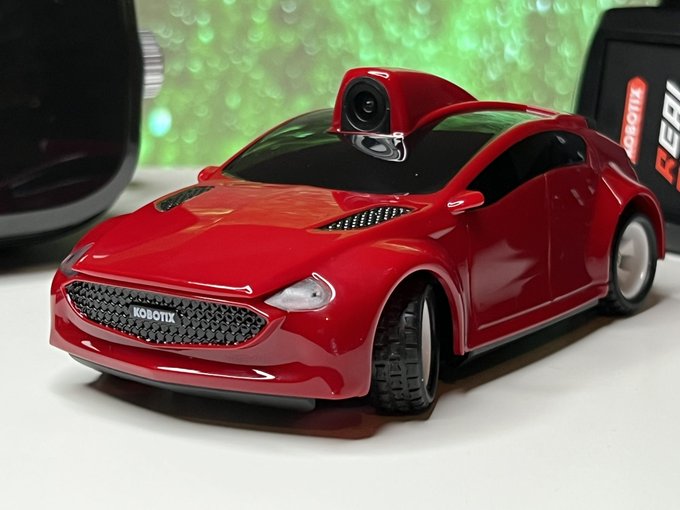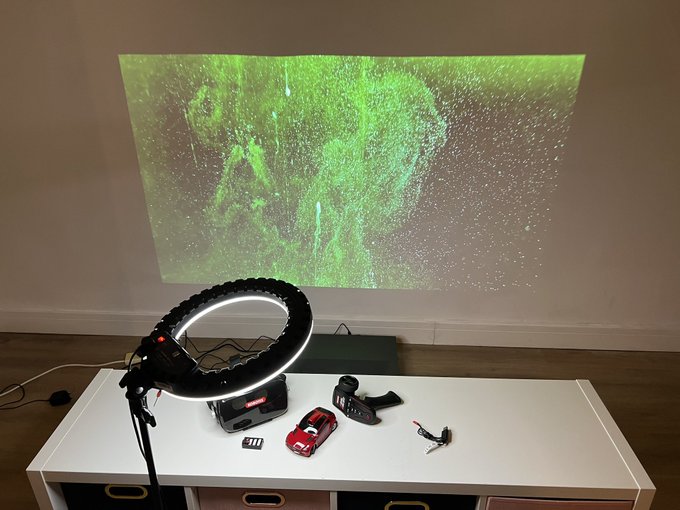Wemax Nova Short-throw 4K Laser Projector Review
The Wemax Nova is a no-frills thrill that demands to be taken seriously, but rewards you with a stunning cinema-like experience and incredible 4K 60Hz gaming performance.
No frills? We’ll get into that- but, in brief, since the Nova is a big, serious projector that isn’t intended to be moved around it eschews the smart autofocus and auto keystone features that make Wemax’s portable projectors so great.
BEHOLD THE ALMOGHTY LETTUCE pic.twitter.com/GNr11yQ8sS
— Phil Howard (@Gadgetoid) December 1, 2022
Thrill? This thing turned my living room wall into a 150” screen with a low enough input lag for me to beat my Lunistice 1-1 speedrun time. In fact the big picture had an immediate and profound impact on my ability to judge precise jumps.
But let’s not get ahead of ourselves. The Nova is Wemax’s entry into the 4K, short-throw projector market. I first tested Dell’s short-throw projector in 2019 and it was a colossal hulking box that they shipped to me in a protective flight case. The Nova is svelte by comparison, but it’s still a big bulky boi.
The general conceit of short-throw is that the throw ratio – the ratio between the distance of a projector to the wall and the size of the projected image – is dialled all the way up to “all the screen please”. This lets you throw a 100” image from a TV stand pushed right up against the wall. With this setup nobody can ever stand up and block the projected image. Bad news if you like shadow puppets, but great news if you don’t want to have to mount the projector to your ceiling.
This also means you can take advantage of the brightness and sharpness of laser projection technology without the imminent risk of, uh, let’s say: unwanted laser/eyeball interactions. While it’s still possible to get your head between the laser projector and the wall, it’s quite a bit more difficult when the two are just a few feet apart. Fortunately the Nova has a motion sensor covering its projection area and – like the Go Advanced – will shut off the picture with a dimmer warning message if it detects anything where it shouldn’t be. This can be a little irritating if you’re just fumbling about to plug something in the back, but since this is a set-up-and-go projector that should not be a problem for normal use.
Placement / Screen Size
The Nova feels most convenient pushed as close to the wall as possible, using the depth of a good TV stand or side cabinet to give it the distance it needs to project a decent sized picture. But the 70” to 100” screen sizes you’ll get from sitting the Nova close to your wall feel like they don’t do this hulking beast the justice it deserves. If you can afford the space, putting the Nova on the floor and pulling it away from the wall can net you a 150” screen (you can’t really go bigger without cutting a hole in your floor or living in a high ceiling house) that really makes the expression “home cinema” feel apt. A 150” screen is difficult to do justice in photographs but for both movies and gaming the experience is profound.
150”, 100”, 70” pic.twitter.com/jd2xgxpdMF
— Phil Howard (@Gadgetoid) November 23, 2022
I’ve settled on something in between, sitting the Nova on the back edge of a low storage unit (an IKEA TROFAST) and pulling it just under 10” from the wall for a roughly 112” diagonal screen. The image stops about 5” short of the ceiling in 16:9, missing the cornice by an inch and starts about 36” from the floor. It’s a touch high- a side effect of the projector throw angle that places the image about 14” above the projector- but nonetheless big, bold and very watchable.
Pushing the TROFAST right up against my skirting board with the back edge of the Nova roughly 2” from the wall results in a modest 65” screen that feels about the right height and is bigger, and less vulnerable to projectiles than my 50” TV. This setup – thanks in part perhaps due to inverse square law – is quite watchable with winter sunlight streaming through the windows but a little underwhelming if you’re looking for a cinematic experience.
Removing my Majority Everest soundbar from the front edge of the TROFAST and pulling the Nova flush with the *front* gives an impressive middle ground. The back edge of the Nova sits 6” from the wall and the projected image is roughly 86” diagonal.
At around 17”/43cm deep and 22”/55cm tall the TROFAST is a particularly deep and low unit especially well suited to the Nova. It’s also small and light enough to slide back against the wall or pull into the room for a larger image. Most TV stands – by virtue of being designed to stand very shallow TVs – are not well suited for the Nova. I might recommend the IKEA BESTÅ pulled a couple of inches away from the wall or the HEMNES with its 47cm deep, flanged top. When shopping for units with a certain depth, be aware that the headline measurements can include drawer fronts, doors and other things that stick out from the profile of the unit.
To get the most out of the Nova you do need to consider placement and pick the right furniture. You might- like me- just be lucky enough to have a good enough wall and stand to make it work, but do check first!
70” looks washed out because of that shot, but it’s suuuuupppeeeerr vibrant. pic.twitter.com/nV6rqVUXgq
— Phil Howard (@Gadgetoid) November 23, 2022
Well. I say “good enough” but the truth is the uneven wall of our 1950s home falls a little short when paired with the Nova. The extreme projection angle of the short throw design exacerbates any unevenness in the projection surface and – even after some sanding and wall prep- I’m not totally happy with the result. The easy fix is a screen- but the projector market will run you anywhere from £200 to £2000 for a fixed-frame screen so you’ll have to make your own choices about how much preserving that 4K fidelity matters to you.
For me it’s less the paint finish- honestly at any distance I don’t notice it – so much as the larger unevenness in the wall. You can definitely get away without a screen at all, but you’ll need either a modern home or freshly skimmed walls to really do it justice.
Keystone / Focus
Setting up the Nova- due to the lack of auto keystone or focus- is quite a manual process. It feels a little strange having to dial in such a sophisticated and expensive piece of equipment manually but it’s generally quite easy to do. My advice with keystone is simply: don’t. In fact this applies to all projectors. Positioning the Nova square against a flat wall so that the image is naturally correct means you make the most of its effective resolution and get the best quality image. If you need keystone correction at all, this is probably the wrong projector for you. That said, competing brands have managed to make keystone correction automatic with the help of a companion app to provide the necessary camera feedback.
Focus is quite another thing. You might have balked earlier at my table-10”-from-the-wall statement. That’s a pretty tall ask of some households and leaves a little dead space behind furniture where toddlers and toys will inevitably find themselves. It’s nice to be able to shove the unit back against the wall, reducing the Nova picture size when it’s not being used to watch a movie, but doing so requires a trip into the projector settings to correct the focus manually.
It’s difficult to really count the lack of focus and keystone automation against the Nova since a typical setup would not and should not need these features.
Besides focus and keystone correction, alignment is a huge deal for the Nova. If it’s not absolutely square with respect to your wall then the picture will be needlessly distorted. While your first temptation might be to keystone correct this away, it’s absolutely worth while getting alignment right. The Nova is conspicuously lacking anything to help you with this, and where other short-throw projectors might have little pull-out wall distance guides the Nova is a BYO darn tape measure affair. It can be difficult to be far enough away to see that your alignment corrections are working and close enough to actually make them. The saving grace is – as long as you don’t move or bump the projector or your furniture – you should only have to do this once.
For leveling the projector the Nova has adjustable feet that can raise or lower the front left and right edges. This is – thankfully – done by means of an adjustment wheel at the left and right edges of the projector, rather than turning the feet themselves. These can compensate for wonky furniture and also adjust the angle of your projector with respect to the wall, eliminating the need for vertical keystone. Again these are fiddly and I’d cry out for motorised feet if it weren’t another set of adjustments you only have to make once.
It’s generally quite difficult to get uniform focus from the top to the bottom of the image, and I think this is because my wall is… quite frankly terrible. While this is noticeable when viewing the focus screen and trying to dial the projector in, it doesn’t seem to affect general viewing. I tend to find that a slightly softer focus, if I can achieve it, is preferable to pin-sharp for viewing. This is my preference, however, and it’s a very fine line. I will update this review with my experience using a projection screen if and when I get my hands on one or build one. If you have an uneven wall like mine, you’ll probably find that biasing the focus so that the top-left corner is sharp gives the best results, most text (at least in English) is left-justified and most common text UI elements (titles and descriptions for content) are found at the top half of the screen.
Software / Android TV / Fire TV
Having some caveats with the OS seems to be a running theme with Wemax projectors. In the case of the Nova it gets a pretty standard Android TV install that unfortunately – like the Wemax Dice – lacks Netflix. Using AFTV News downloader to grab and install an Android TV Netflix .apk rectified this pretty quickly and I’ve had reasonable success running Netflix directly on the Nova. It’s not perfect, however, and is prone to starting up with a black screen, crashing and will spawn “This device is not optimised for Netflix” dialogs. Wait, isn’t the application supposed to be optimised for the device!?
Gone full bananas using the @wemaxprojectors Nova and the @MajorityAudio Everest to build a not-exactly-budget home cinema ?
I think I need a screen like https://t.co/T80fivV8jd my wall is even less flat than I’d thought ?
Side-loading Netflix was easy. No AFTV needed. pic.twitter.com/Saz2MymJIR
— Phil Howard (@Gadgetoid) November 22, 2022
The rest is pretty much what you’d expect from a standard Android TV device- all the usual content applications (which I never use) are preloaded and Amazon Prime Video (we don’t have a Disney+ subscription right now) works fine along with YouTube and SmartTube Next.
Taking Wemax’s recommendation and pairing an Amazon Fire TV really dials things up. I made use of the Black Friday sales to grab a 4K “Max” Fire TV Stick (yes on top of the 1080p one I purchased for testing 1080p projectors, ugh) and am happy to report it works great with the Nova. Yes it’s sort of disingenuous to replace the smarts in a product with other smarts and I genuinely believe integrated smart TV should concede to HDMI dongles, but it seems to be a fact of life now.
The 4K Fire TV Max works with HDMI CEC, allowing the Nova’s remote control to give somewhat basic command over its features. Things are limited, though, with the menu button and home button taking you back to the built-in Android TV. It works much better if you just concede and use the Fire TV remote.
The Fire TV stick needs its little pigtail HDMI extension cable to plug into the Nova. This is the safe and sensible way to do, since it doesn’t provide any leverage on your HDMI ports, but does mean the stick dangles somewhat out of the back and is prone – since I keep moving my table back and forth – to getting jammed against the wall.
When setting up the Fire TV you’ll also be railroaded into an “Equipment Control” setup menu which encourages you to add a TV that the power and volume buttons on the remote can then control. The list of TV brands is exhaustively long and “Wemax” does not appear in it. In fact as far as I can tell the “Equipment Control” feature requires an infrared device, while the Nova remote is purely Bluetooth. If you want to control both volume and the connected Fire TV then using the Nova remote is your only choice.
Inputs / Outputs
The Nova has three HDMI ports which gave me ample room for a Fire TV, JSAUX Steam Deck dock and an HDMI ARC cable to the Majority Everest soundbar. Joining these are a USB 2.0 port (unsuitable for powering external devices), a 3.5mm TRS audio output, a 3.5mm TRRS A/V input (composite in disguise), an S/PDIF optical output (if you run out of ports for ARC) and an Ethernet port.
There’s also a USB port hidden near the bottom edge on the right-hand side of the Nova. I almost missed it. It’s useful since the infra-red body sensor on the projector is quite sensitive and will trigger if you try fumbling around the back to insert a USB drive. Having one on the side, near the front makes it much easier to attach a drive of totally-legally-obtained movies.
Surprise USB port on the front right of the @wemaxprojectors Nova. Seems to run my Fire TV 4K Max without it complaining about low power. Wat? pic.twitter.com/QONUKART0w
— Phil Howard (@Gadgetoid) December 1, 2022
If the size didn’t clue you in, the range of ports really cements how the Nova is a set and forget projector. While it’s possible to move it around, it’s really not something you’ll do regularly.
Sound
During my tests ARC worked to deliver audio from the Fire TV and my docked Steam Deck to the Majority Everest 5.1 setup. In many setups- however- the three (four, if you count Bluetooth) ways you can get audio out of the Nova are redundant since its built-in, front-facing speakers are punchy and pointed right out toward your viewing area. There’s no spatial 3D audio – you’ll have to BYO surround for that – but the integrated speakers make use of the sheer bulk of the Nova to be extremely capable for gaming and TV viewing. They’ll probably knock the socks off your regular TV, anyway.
The speakers are ported out of the bottom of the projector, giving pretty solid bass performance for its size. Imagine a good quality soundbar stuck to the front and you’ll get the idea. With the volume cranked (sorry neighbour) the bass drop from Daft Punk’s Doin’ It Right is handled gracefully though the brutal descending bass wobble from Karsh Kale’s Distance reduces them to a buzzing, distorted mess. Some of the weight is lost from the unsettling score at the end of Annihilation, too, so if you’re planning a full home cinema – and not just TV replacement – experience then budget for a 5.1 setup.
Perhaps the best thing about the Nova’s sound is that it comes from the “right” direction as standard. Traditional all-in-one home projectors tend to be placed behind you, absolutely requiring an additional soundbar or speaker in order to place the audio beneath the screen. The Nova, designed to be placed right up against your wall and with speakers integrated, acts more like a television with audio and visuals coming from the same direction.
Gaming
If you’ve ever wondered what renting a cinema for a round of The Videogames would feel like, the Nova comes pretty close to answering. It does so without the hassle – presumably – of trying to get a reliable controller connection anywhere but the back row. The Nova is a gaming behemoth, with its standard input lag being low for a projector (around 120ms) and dropping to roughly 40ms – the measured difference between my laptop screen and the projector running a stopwatch in mirrored mode – in “Gaming Mode”. In both cases this was with extreme keystone correction applied, a feature that’s often lost (since it requires image processing) to gain some extra response time for gaming mode. Indeed keystone correction made no difference whatsoever to my measured times, so in the unlikely event you really do want to use it, it won’t ruin gaming performance.
Okay gaming mode input lag on the @wemaxprojectors Nova is *very acceptable*. This is how I’m doing all my Lunistice speedrun attempts now ? pic.twitter.com/vj0prLPq9B
— Phil Howard (@Gadgetoid) November 23, 2022
Moving the Nova off its stand and onto the floor, pulling it away from the wall, and letting it project a glorious 150” near floor to ceiling picture is a truly awe inspiring way to experience games. This is what I did with my Steam Deck, albeit it’s not quite up to the task of driving a 4K, 60Hz display for many games. I found the latency more than low enough to manage the precise jumps required for speedrun attempts in Lunistice, and the enormous screen proportions make judging distances and timing jumps quite a bit easier.
— Phil Howard (@Gadgetoid) November 24, 2022
The low latency gaming mode is – however – only available on HDMI inputs and while the normal projector latency is pretty low (I’m assuming the 120ms non-gaming mode HDMI latency also applies to Android here) you might find it untenable for Android TV gaming or streaming videogames directly via the integrated OS. Classic console emulators – as usual – will probably be fine, but I think it’s fair to say that those might be a gross misuse of such a glorious, 4K behemoth. If you want to run Steam Link, XCloud or similar then you’ll have to lean on a Fire TV or similar.
The Bad & The Ugly
Despite its generous provisions for external devices the Nova remote is the stock standard remote you’ll find with other smart television devices and – indeed – across Wemax’s more portable range. As such it lacks dedicated buttons for switching to HDMI inputs, making the process an arduous trip via the Android TV OS.
The smarts also mean the Nova takes 30-50 seconds to boot to a usable state, appearing fully started up at roughly 37 seconds from a cold boot but intermittently unresponsive until everything has settled. A 4K Fire TV is a great complement to the Nova, but the little dance to start up and switch to its input is something I’d like to see optimised.
Additionally when viewing an HDMI input you have to rely on remembering somewhat arcane long-press actions on buttons to adjust settings. A long press on the middle/select button of the Nova’s remote will reveal an Image, Sound and Settings menu giving the opportunity to switch between image modes – including gaming mode – brightness modes, sound settings, Dolby enhancements and switching HDMI 2.0 on/off.
While Netflix does install and tends to run- insofar as I can tell with just HD content- fine it is prone to popping up “This device is not optimised for Netflix” error messages. Due to how HDMI inputs are handled these seem to pop up over the Fire TV UI occasionally. The simple answer here is just don’t side-load Netflix if you plan to use an external device.
HDMI ARC and CEC don’t seem to be there for multi device setups like this. More often than not I find myself needing three remotes since the Fire TV remote cannot control the volume and the Nova remote won’t work with Fire TV’s voice search, lacks its shortcut buttons and more. The third remote? Sometimes I have to dial in the individual channels of my soundbar, I can’t really blame that on the Nova.
Finally, and perhaps the most salient of all gripes with the Nova, is the lack of a sleep mode in the power menu. This means you can either leave it running, with the whole system enabled, belching out heat, humming away and projecting blackness (since a Fire TV stick will eventually sleep to a black screensaver) or you can turn it off. Depending on how concerned you are about energy usage you can do both, since leaving the projector on during the day – I’ve done so accidentally plenty of times – doesn’t do it any harm and the lower brightness standby, black screen shouldn’t (I haven’t confirmed this, what say you Wemax?) burn through your projectors lifespan. I hasten to add that – while the Nova is “off” you can still turn it back on with the remote, so this is really a cold standby mode. And… is 30 seconds really that long? It certainly starts up faster than my TV.
While there are downsides to this behemoth of a projector they’re all quite tolerable. It’s a small price to pay – outside of the actual price, that is – for such an convenient big picture. Retrospectively ceiling mounting something in a UK house is not an easy or cheap thing to do – we had some conduit running around our living room when we moved in that we had moved to inside the ceiling, it was a nightmare – so being able to create a home cinema with some cheap IKEA furniture, a big enough wall and the Nova is a heck of a proposition.
The Price and the summary
The RRP of the Nova is a whopping $2,699 which places it squarely in “you really must want a home cinema” territory. Wemax, however, are not shy about offering almost continuous discounts and you can usually snag it for around $1,890. There are also refurbished units up for grabs at $1,699 but for the extra $200 or so I’d forgive you for wanting to go brand-new on sale.
Without directly benchmarking the Nova against its competitors I can’t really levy any relative criticism, but I have one salient complaint- where’s the lens cover? The upward-facing, recessed lens of the Nova is especially vulnerable to dust and detritus and particularly alluring to toddlers. Couple this with the need to place it on a low stand and you’ve got a recipe for disaster. A sliding lens cover similar to that of the BenQ V6050 would be welcome.
The sheer automated magic of the Wemax Go Advanced has spoiled me somewhat and while the Nova only needs set up once- since it’s not intended to be portable- I can’t help but wish for some auto focus, levelling and keystone frills because – intentionally or not – the Nova is “compact” and self contained enough to heft around.
This is projecting onto my shitty wall ? pic.twitter.com/dI8t1M3ovZ
— Phil Howard (@Gadgetoid) December 1, 2022
Overall the Nova offers a stunning image and impressively tolerable gaming latency in a package that’s a little lacking in focus and keystone assist but has plenty of connectivity options, punchy speakers and – although it’s understandably a chonky beast – simple, unobtrusive good looks. It makes a lot of demands upon you for optimum placement, the right stand, a good wall or screen, but if you’re willing to curate your cinema experience I’m confident you’ll be floored by the results.
Random Exploits Addendum
After my attempts to use the Wemax Dice as a digital blue/green screen – I don’t have the space or the patience to hang a real screen in my living room – I swore I’d try the Nova. The short throw means, in theory, that I could place it *behind* me and avoid illuminating myself directly with the game blue/green light I was attempting to “paint” the wall with. This worked – sort of- insofar that separation between me and the background was much cleaner. However the Nova is bright and my wall is rough, scattering light to the literal four corners (okay it’s more like 12 or something) of my living room. This bounce lighting inevitably illuminated me and broke the ability of iMovie (on iOS no less) to get a clean chroma key. I will probably try this again at some point, but in the short term it turned out more difficult than I expected to use the Nova as a digital blue/green screen. Ironically I probably need a projection screen to get cleaner, less bouncy illumination… at that point I might just as well mount some green fabric!
The full setup, using a @streamplify ring light and @wemaxprojectors Nova. pic.twitter.com/u3NDm5fls1
— Phil Howard (@Gadgetoid) November 23, 2022
As for a photography backdrop, things fared a little better. Again, the short throw of the Nova allowed me to project a backdrop behind a subject without directly illuminating it with the same imagery. I queued up ten hours of 4K abstract nonsense on YouTube and took some photos of an RC car I’ve been testing. The biggest problem I found here was that the Nova projects fairly high up the wall, so I needed a higher table in order to frame my subject toward the middle of the projected screen. I could probably play with distances and staging for hours to get better results, but in only a half hour or so I was getting shots not far off what I wanted. Good enough for my review, anyway.
The shot vs the setup.
Using a @wemaxprojectors Nova to provide background interest for a blog photo.
And – of course – out comes the @streamplify 14” ring light again. pic.twitter.com/zpygEYm4aP
— Phil Howard (@Gadgetoid) November 24, 2022
